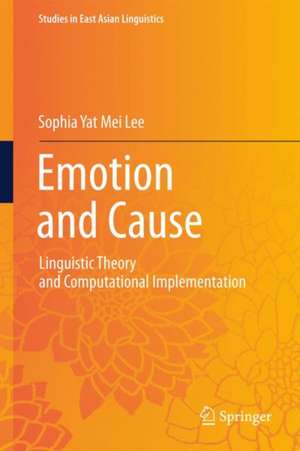Emotion and Cause: Linguistic Theory and Computational Implementation: Studies in East Asian Linguistics
Autor Sophia Yat Mei Leeen Limba Engleză Hardback – 5 dec 2018
This work argues that cause events, being the most tangible component of emotion, provide a rich dimension of how emotions should be classified. While it is often claimed that emotional concepts cannot be defined, this work views emotion as a response triggered by actual or perceived events, specifically focusing on the interaction between five primary emotions (Happiness, Sadness, Fear, Anger, and Surprise) and cause events. Cause events are examined in terms of two dimensions, namely transitivity and epistemicity. By incorporating the semantic and syntactic information of emotion cause events, this representation of emotion not only provides deep linguistic criteria of emotion cause events, but also offers an event-based approach to emotion classification. A text-driven, rule-based system for detecting the causes of emotion is then developed to establish the validity of the proposed linguistic model for emotion detection and classification. The system shows promising results.
Preț: 387.75 lei
Nou
Puncte Express: 582
Preț estimativ în valută:
74.19€ • 77.47$ • 61.41£
74.19€ • 77.47$ • 61.41£
Carte tipărită la comandă
Livrare economică 05-19 aprilie
Preluare comenzi: 021 569.72.76
Specificații
ISBN-13: 9789811061929
ISBN-10: 9811061920
Pagini: 153
Ilustrații: XII, 151 p. 85 illus., 6 illus. in color.
Dimensiuni: 155 x 235 mm
Greutate: 0.41 kg
Ediția:1st ed. 2019
Editura: Springer Nature Singapore
Colecția Springer
Seria Studies in East Asian Linguistics
Locul publicării:Singapore, Singapore
ISBN-10: 9811061920
Pagini: 153
Ilustrații: XII, 151 p. 85 illus., 6 illus. in color.
Dimensiuni: 155 x 235 mm
Greutate: 0.41 kg
Ediția:1st ed. 2019
Editura: Springer Nature Singapore
Colecția Springer
Seria Studies in East Asian Linguistics
Locul publicării:Singapore, Singapore
Cuprins
Abstract.- Acknowledgements.- Table of Contents.- List of Figures.- List of Tables.- Introduction.- Theoretical Framework and Methodology.- Emotion Cause Representation and Transitivity.- Epistemic Markup of Emotion Causes.- A Linguistic Model of Emotion.- Emotion Cause Detection.- Conclusion and Future Research.- Appendix.
Textul de pe ultima copertă
This work argues that cause events, being the most tangible component of emotion, provide a rich dimension of how emotions should be classified. While it is often claimed that emotional concepts cannot be defined, this work views emotion as a response triggered by actual or perceived events, specifically focusing on the interaction between five primary emotions (Happiness, Sadness, Fear, Anger, and Surprise) and cause events. Cause events are examined in terms of two dimensions, namely transitivity and epistemicity. By incorporating the semantic and syntactic information of emotion cause events, this representation of emotion not only provides deep linguistic criteria of emotion cause events, but also offers an event-based approach to emotion classification. A text-driven, rule-based system for detecting the causes of emotion is then developed to establish the validity of the proposed linguistic model for emotion detection and classification. The system shows promising results.
Caracteristici
An important and innovative contribution, combining linguistic knowledge and a computational approach Provides a thorough literature review of emotion analysis in the fields of linguistics, psychology, sociology and computer science Holds great implications not only for the linguistic theory of emotions, but also for the linguistic account of events as well as the automatic detection and classification of emotion in language technology


